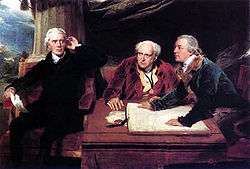John Baring (1730–1816)

John Baring (5 Oct 1730 – 29 January 1816) of Mount Radford House, Exeter, Devon, was an English merchant banker and MP.[2]
Origins
He was the eldest son of Johann Baring (1697–1748), (John I Baring) a clothier from Bremen in Germany who had settled in Exeter, where he built up a large business and obtained English citizenship, having Anglicised his name to "John". The younger John was brought up at Larkbeare, his father's country residence just outside the city of Exeter. His younger brother and later business partner was Sir Francis Baring, 1st Baronet.[2]
Career
In 1748 following his father's death he inherited the large family cloth business in Exeter. Together with his younger brother Francis, he extended his commercial interests to London by setting up the partnership of John and Francis Baring, of which he was the senior partner. He soon retired from activity in London to concentrate on business in Devon, and left the running of the London business to Francis, under whose guidance it evolved into Barings Bank.[2]
Back in Devon John founded banks at Plymouth and Exeter and entered politics. Having unsuccessfully contested Honiton, he was elected Member of Parliament for Exeter in 1776. He was also appointed Sheriff of Devon for 1776.[2] He retired from Parliament in 1802.
Marriage & progeny
He married Anne Parker (d.1765), the daughter of Francis Parker of Blagdon in the parish of Paignton in Devon, by whom he had two sons and four daughters, including:
- Charlotte Baring (1763-1833), his youngest daughter, who in 1786 married John Jeffrey Short (b.1753), son of John Short "Senior" of Bickham House, Kenn, near Exeter (who in 1744 was a partner with John II Baring and his brother Charles Baring in the Baring's bank in Exeter), by his wife Susanna Vowler, a cousin of Charlotte's paternal grandmother Elizabeth Vowler (d.1766). Her eldest son was John Short (1790-1818) who died unmarried and was succeeded at Bickham by his brother Francis Baring Short.[3]
Death
John Baring died in 1816.
Residences
In 1755 he purchased for £2,100 the estate of Mount Radford in the parish of St Leonards,[4] on the outskirts of Exeter, adjacent to his father's residence of Larkbeare. He also purchased the adjoining manors of Heavitree and Wonford.[4] In 1810 he had an additional residence at West Teignmouth House in the parish of West Teignmouth.[5] In the last year of his life he encountered financial difficulties and sold Mount Radford and his other Exeter properties to his cousin Sir Thomas Baring, 2nd Baronet (1772–1848) , who later sold them to a commercial builder.[6]
References
- ↑ http://www.npg.org.uk/whatson/exhibitions/2010/thomas-lawrence-regency-power-and-brilliance-minisite/thomas-lawrence-explore.php
- 1 2 3 4 "BARING, John (1730-1816), of Mount Radford, Exeter, Devon". History of Parliament Online. Retrieved 2012-05-14.
- ↑ Biography of Charlotte Baring, in Women Who Made Money: Women Partners in British Private Banks 1752-1906, by Margaret Dawes & Nesta Selwyn, pp.127-130
- 1 2 Dawes & Selwyn, p.127
- ↑ Swete, John, Names of the Noblemen and Principal Gentlemen in the County of Devon, their Seats and Parishes at the Commencement of the Nineteenth Century, 1810, published in 1811 edition of Risdon, Tristram (d.1640), Survey of Devon, London, 1811, with 1810 Additions
- ↑ Dawes & Selwyn, p.130
| Parliament of Great Britain | ||
|---|---|---|
| Preceded by Sir Charles Bampfylde, 5th Bt John Rolle Walter |
Member of Parliament for Exeter 1776 – 1800 With: Sir Charles Bampfylde, 5th Bt James Buller Sir Charles Bampfylde, 5th Bt |
Succeeded by Parliament of Great Britain |
| Parliament of the United Kingdom | ||
| Preceded by Parliament of the United Kingdom |
Member of Parliament for Exeter 1801 – 1802 With: Sir Charles Bampfylde, 5th Bt |
Succeeded by Sir Charles Bampfylde, 5th Bt James Buller |